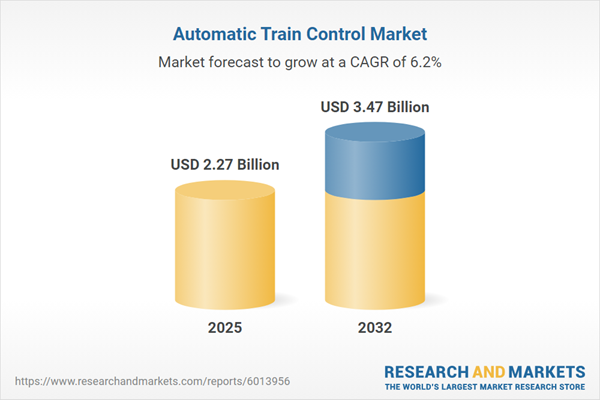Speak directly to the analyst to clarify any post sales queries you may have.
The automatic train control market is evolving rapidly, shaped by advancements in digital signaling, increased automation, and shifting regulatory landscapes. Senior executives now face pivotal choices as technology, safety, and commercial priorities intersect more sharply across a transforming global rail sector.
Market Snapshot: Automatic Train Control Market Growth & Outlook
The automatic train control market grew from USD 2.14 billion in 2024 to USD 2.27 billion in 2025. It is projected to continue expanding at a CAGR of 6.20%, reaching USD 3.47 billion by 2032. Market momentum is reinforced by increasing urbanization, a strong emphasis on network safety, and modernization initiatives in both developed and emerging economies.
Scope & Segmentation of the Automatic Train Control Market
This report provides a detailed analysis of market structures and deployment across functions, applications, and major regions. Key segmentation highlights include:
- Train Control System: Fixed Block, Moving Block
- Application: Light Rail, Main Line, Metro
- Equipment: Hardware (On Board Equipment, Track Side Equipment), Services (Consultancy: Design Consultancy, Integration Consultancy; Maintenance: Corrective Maintenance, Preventive Maintenance), Software (Control Software, Monitoring Software)
- Regions: Americas (North America: United States, Canada, Mexico; Latin America: Brazil, Argentina, Chile, Colombia, Peru), Europe, Middle East & Africa (Europe: United Kingdom, Germany, France, Russia, Italy, Spain, Netherlands, Sweden, Poland, Switzerland; Middle East: United Arab Emirates, Saudi Arabia, Qatar, Turkey, Israel; Africa: South Africa, Nigeria, Egypt, Kenya), Asia-Pacific (China, India, Japan, Australia, South Korea, Indonesia, Thailand, Malaysia, Singapore, Taiwan)
- Leading Companies: Siemens Mobility GmbH, Alstom SA, Thales S.A., Hitachi Rail STS S.p.A, CRRC Corporation Limited, Wabtec Corporation, Mitsubishi Electric Corporation, Construcciones y Auxiliar de Ferrocarriles S.A., Kawasaki Heavy Industries Ltd., Toshiba Infrastructure Systems & Solutions Corporation
Key Takeaways on Strategic and Commercial Drivers
- Technological progress is shifting investment from hardware-centric systems to modular, software-defined architectures that enable phased upgrades and continuous service delivery.
- Operators face complex trade-offs between established legacy signaling and emerging dynamic capacity systems, balancing long-term serviceability with interoperability and cybersecurity mandates.
- Moving block solutions are prioritized in high-density urban corridors, while main line and light rail retain their own integration and interoperability needs.
- Mergers, strategic alliances, and ecosystem partnerships are growing as industry players pursue integrated offerings covering control logic, predictive analytics, and maintenance services.
- Vendor selection increasingly considers not only technical excellence but also capabilities in lifecycle service, system integration, and compliant cybersecurity frameworks.
- Regional adoption patterns differ, with Asia-Pacific focusing on rapid network expansion, the Americas on incremental modernization, and EMEA balancing policy harmonization and network interoperability.
Tariff Impact on the Automatic Train Control Market
- The 2025 United States tariffs drive supply chain reassessment, compelling stakeholders to diversify sourcing and consider nearshoring for sensitive subsystem components.
- Procurement roadmaps now include new risk-mitigation clauses and foster local production partnerships, affecting project timelines and service models due to shifting logistics and certification needs.
- Evaluating tariff exposure is now part of the decision criteria for hardware, software, and service suppliers, with an increased focus on contractual flexibility and operational resilience.
Methodology & Data Sources
The research draws on structured interviews with industry stakeholders, review of regulatory documentation, and triangulation of vendor data. The analysis follows a system-of-systems approach, applying scenario modeling and technical validation to ensure accuracy and relevance of findings.
Why This Report Matters for Industry Decision-Makers
- Supports evidence-based technology selection and procurement planning across the entire lifecycle of rail automation and control systems.
- Enables proactive risk management regarding geopolitical, regulatory, and cybersecurity developments relevant to contemporary rail networks.
- Guides actionable strategies for aligning operational efficiency, system safety, and commercial value in a dynamic market.
Conclusion
As the automatic train control market navigates rapid technological advancement and shifting regulatory environments, leaders equipped with data-driven insights will be positioned to balance innovation, compliance, and operational excellence for future-ready rail networks.
Additional Product Information:
- Purchase of this report includes 1 year online access with quarterly updates.
- This report can be updated on request. Please contact our Customer Experience team using the Ask a Question widget on our website.
Table of Contents
3. Executive Summary
4. Market Overview
7. Cumulative Impact of Artificial Intelligence 2025
Companies Mentioned
The companies profiled in this Automatic Train Control market report include:- Siemens Mobility GmbH
- Alstom SA
- Thales S.A.
- Hitachi Rail STS S.p.A
- CRRC Corporation Limited
- Wabtec Corporation
- Mitsubishi Electric Corporation
- Construcciones y Auxiliar de Ferrocarriles, S.A.
- Kawasaki Heavy Industries, Ltd.
- Toshiba Infrastructure Systems & Solutions Corporation
Table Information
| Report Attribute | Details |
|---|---|
| No. of Pages | 189 |
| Published | October 2025 |
| Forecast Period | 2025 - 2032 |
| Estimated Market Value ( USD | $ 2.27 Billion |
| Forecasted Market Value ( USD | $ 3.47 Billion |
| Compound Annual Growth Rate | 6.2% |
| Regions Covered | Global |
| No. of Companies Mentioned | 11 |









